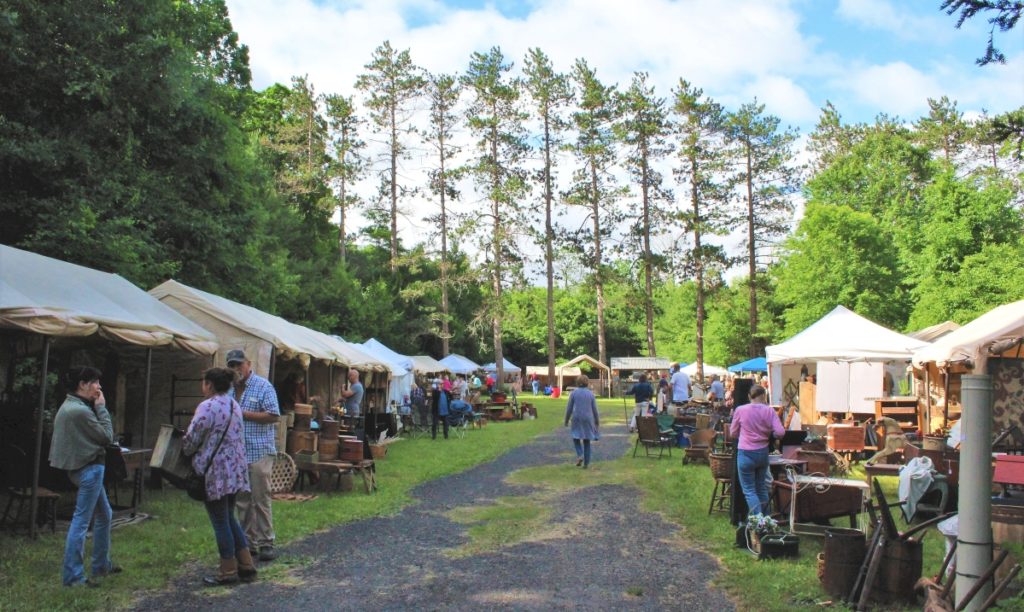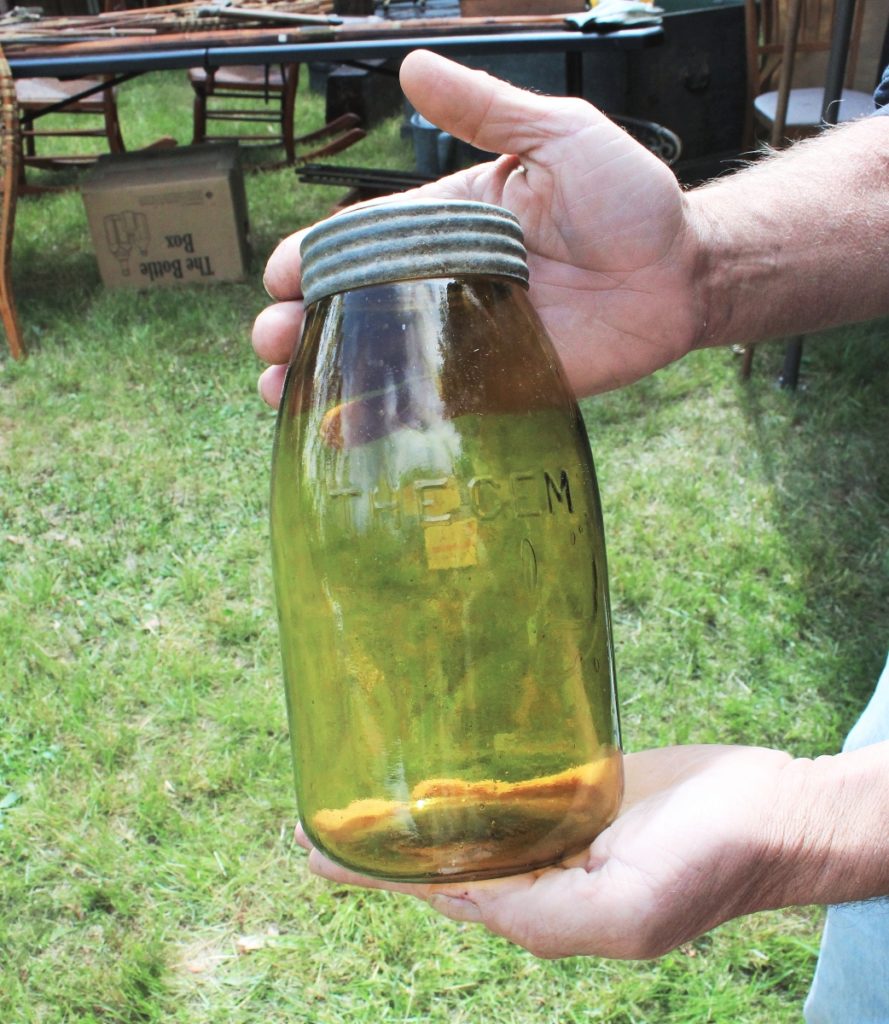
The Walker Homestead offered food at a concession stand and had live music, performed by Grade “A” Fancy of Worcester, Mass., giving the show a fairground feeling.
Review and Photos by Z.G. Burnett
BROOKFIELD, MASS. – A chill breeze blew through the sunny morning air on June 18, creating an almost autumnal feeling mingled with the sweet smell of new grass and the canopy of shade provided by full green leaves that surrounded the Walker Homestead. Better brisk than boiling hot, it proved the perfect weather for their Antiques & Primitive Goods Sale. That is, as long as the gusts of wind didn’t blow any tents away.
The Walker Homestead was built from 1698 to about 1750 by the Walker family, who were originally from Woburn and among the area’s first settlers. The Walkers lived there until the 1850s, when the homestead passed through a few different hands before it was bought by a woman named Margaret Phelps in the 1920s as a summer home. Phelps planted many of the gardens that surround the homestead and stayed there regularly until 1978. Kris and Ian Casucci, who own and operate the sale, bought the homestead in 1984 and have raised five children while living there. They first opened their home to the public in 2009 and began hosting antiques shows in 2010. Walker Homestead is open to the public three times a year: in June and September for the antiques show, and in early December for their Holiday Open House. This marks their 13th year of operating two annual antiques shows.
“Our show is different from most,” said Kris Casucci, “It’s antiques with a hand-picked selection of quality handmade artisans mixed in. With a live band and historic grounds, it feels more like a fair!”

One of two rooms in the Walker Homestead that were open to the public during the show, almost everything in this garden-facing chamber was for sale.
The mood was indeed joyful as more than 40 dealers prepared their booths for the coming day, some making convincing facsimiles of period rooms within their tents. Two rooms of the homestead were open to showgoers, in which almost everything was for sale. The Garden Shop was also open for business, arranged more like a comfortable parlor than a potting shed. Marlo Paju, founder of Flying Pig Antiques & Auctions in Westmoreland, N.H., spent more than a week preparing these spaces for the event. “She’s a truly talented person,” Casucci commented, “and a good friend!” Paju shared similar sentiments about the Casuccis, who are now partners with Ian McKelvey and Roxanne Reuling at Flying Pig, “They’ve really done a wonderful job.”
The line of buyers began to form around 9 am, when early birds occupied the best parking spots in an adjacent field. According to Casucci the gate was normal, which meant it was packed. By opening time at 10 am, the line extended down into the parking lot. “This is the fullest it’s been since Covid,” she added near midday. Enclosed within the thicket of tall trees on the homestead grounds, the show felt like a well-kept secret despite its continuous operation. The dealers are seasonally rotating cast; some prefer to do the spring show, while others only sell in the fall. Half of those at the spring show have been selling at the homestead since the show’s beginning, and many more have been dealing there for almost ten years. Some operate under the banner of existing businesses, while others are solo shows, and all participate in at least one other show nearby. Most dealers started the day with a few “sold” tags even before gates opened, and sales were good overall.

Jerrilyn Mayhew of Woodsview Antiques (Sandwich, Mass.) displayed this intriguing sign on her tentpole. Painted by hand, the lettering was copied from a gravestone or rubbing and signed “A Writ of History/Concord, Mass.” and was selling for $85.
Within Americana and primitives, no one category was underrepresented. While most booths were offering a bit of everything, some were mostly devoted to just one or two types of antiques. This kind of specialty is becoming more and more scarce in open-air markets. “There aren’t many like this anymore. It’s such a great, concentrated show,” said Lucille B. Festa of American Country Rugs. Festa is one of the select artisans who sells handmade hooked rugs based on patterns in her collection of early examples in addition to rugs of her own design. She produces period-appropriate dyed wool and textiles, which talented customers can use to create their own rugs with one of her pattern kits. Festa also offers commissioned rugs, for those with the patience to wait for about a year while she makes them.
Hooked rugs and textiles were popular throughout the show, as this category has been trending especially with younger buyers. M&J Antiques of Pomfret Center, Conn., had an impressive display of antique and vintage quilts at the front and center of its booth, hung on a three-tiered drying rack that seemed to retain its original paint. They also had a colorful display of painted Shaker buckets, all reasonably priced in the low hundreds, arranged against a backdrop of quilts and flanked by a solid grouping of samplers. Linda and David Brown of Cargill Antiques, which is his family name, was also selling antique quilts within their homelike tent. David shared that all their stock is from in and around White River Junction, Vt., where he and generations of his family have lived and worked.
Two hooked rugs stood out among the booths. The first was late Nineteenth or early Twentieth Century example that belonged to Rick Fuller Primitives of South Royalton, Vt., with an unusual geometric pattern that resembled contemporary nautical flags. Fuller’s booth was artfully arranged like a country tavern, complete with a table and chairs at the front as though awaiting guests. The second rug was of the same era, but less abstract in design. Offered by Bayberry Antiques of Rockland, Mass., it was mounted on a frame and hooked onto linen, with two roses, a vine border and the wistful message “Remember Me.”

This circa 1760s Chippendale tea caddy from Matt King of Marshfield, Mass., was truly a hidden gem. Retaining its original hardware and all three covers for its interior compartments, the caddy had been preserved well and had a price tag of $550.
A few booths over, Ernest Eldridge of E.S. Eldridge Auctioneer (Willimantic, Conn.) was dressed to match his stock with knee-high boots and a tricorn hat bearing the cockade of General Jean-Baptiste de Rochambeau (1725-1807), who passed Eldridge’s town on the route from Rhode Island to Yorktown, Va., in 1781. In his campaign tent was a handsome Chippendale long case clock signed by Chisholm Dumfries and dated 1797. It’s unclear whether the clock was crafted by the Scottish maker Adam Chisholm Dumfries, who is cited by variations of his name on different clocks. This example’s face was decorated with roses and an exotic bird, selling for $375.
There was a wide selection of early furniture in most tents, and a few went above and beyond in creating exterior interiors for the show. Vaughn Antiques of Stafford Springs, Conn., featured an entire fireplace, complete with a mantel and paneled backboard. Long Cabin Country Primitives of North Granby, Conn., seemed to materialize the entire ground floor of an inn. Had there been a prize for presentation among the dealers, there would have been fierce competition overall.
Other dealers were intent on presenting only a few kinds of items. George Browning III of George Browning Stoneware (Swanzey, N.H.) was offering special prices on any item in his booth that wasn’t included in his shop name’s category. His focus is understandable; although each crock and jug is unique, Browning offered rare forms and designs, the majority of which were in excellent condition.

Elaine Fleming of Middleboro, Mass., was asking $175 for this early table; it had some condition issues but was still fairly sturdy for being nearly two centuries old.
Each and every variety of pottery was available at the show, which was anxiously watched by dealers and buyers alike to prevent any breakage from the wind. Pantry Box Antiques of Stafford Springs, Conn., arranged their slipware alongside their redware, highlighted by the surrounding antique kitchen goods. Across the field, Kulina Folk Art displayed their original designs of redware, sgraffito and slipware. Owners Gariné Arakelian and Rick Hamelin of Warren, Mass., have been making pottery together since 1990, and each of their forms is made and decorated by hand. An hour or so into the show, much of their product had been carried off as a new heirloom.
Glass was peppered throughout the show in decorative and antique forms, but most highly concentrated in the booth at the very end of the field. At the helm was Ross Swiechowicz who, with his wife Rose, has been organizing Marier’s Antique Flea Market in nearby Palmer, Mass., for 43 years. Swiechowicz himself is from Greenville, S.C., and has been digging for bottles since he was 7 years old. Some of the richly varied offerings in glass were from his father, a collector, but most were his own. Swiechowicz and his brother both continued the familial pursuit, and he was also selling stoneware and smalls.
Joe and Cindy Shepard of Hometown Antiques (West Brookfield, Mass.) were also doing well with polychrome goods. Their booth was packed with customers, and many “sold” tags had appeared by the time we were able to get in, including on a red and gold painted seater fragment. “I can’t resist decorated pieces,” Cindy commented, and with good reason! The fragment sustained a few losses appropriate to its age and function but was still an excellent find.

The unassuming prize of Ross Swiechowicz’s glass collection; this form of canning jar is usually found in aqua, but this amber jar may be the only example of its kind. It was priced at $10,000.
Furniture was available in abundance, prompting questions throughout the sale as to why people pay so much for “shabby chic” treatments when primitive goods provide them almost gratis. Carol Lee of Ye Old Farmhouse (Willington, Conn.) offered an unusual early Nineteenth Century desk with an opening tilt top and four drawers for storage. Worthy of Ichabod Crane, all one needed was $285 and a high desk chair to match.
With the growing interest in reasonably priced antique furniture that was made to last, it was inspiring to see a handful of newcomers and a few young families in the crowd of veteran buyers. The merchandise on display at the Walker Homestead could have outfitted many homes, old and new. With the coming season and the market resurging, discoveries are ripe for those who know where to pick.
The Walker Homestead is at 19 Martin Road, and their next Antiques & Primitive Goods Show is September 24. For more information, 508-867-4466 or www.walkerhomestead.com.




























